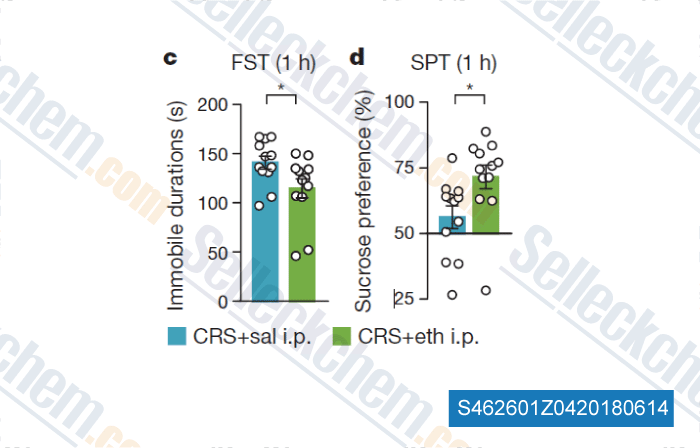|
Toll Free: (877) 796-6397 -- USA and Canada only -- |
Fax: +1-832-582-8590 Orders: +1-832-582-8158 |
Tech Support: +1-832-582-8158 Ext:3 Please provide your Order Number in the email. |
Technical Data
| Formula | C7H11NO2 |
||||||
| Molecular Weight | 141.17 | CAS No. | 77-67-8 | ||||
| Solubility (25°C)* | In vitro | Water | 100 mg/mL (708.36 mM) | ||||
| DMSO | 28 mg/mL (198.34 mM) | ||||||
| Ethanol | 28 mg/mL (198.34 mM) | ||||||
| In vivo (Add solvents to the product individually and in order) |
|
||||||
|
* <1 mg/ml means slightly soluble or insoluble. * Please note that Selleck tests the solubility of all compounds in-house, and the actual solubility may differ slightly from published values. This is normal and is due to slight batch-to-batch variations. * Room temperature shipping (Stability testing shows this product can be shipped without any cooling measures.) |
|||||||
Preparing Stock Solutions
Biological Activity
| Description | Ethosuximide(Zarontin) is a succinimide anticonvulsant, used mainly in absence seizures; A calcium channel blocker. |
|---|---|
| In vitro | Ethosuximide(ETH) enhances hippocampal derived NSC proliferation and neurospheres formation in vitro. Low concentration of ETH induces proliferation of NSC, while higher concentrations of ETH are cytotoxic. Also, ETH activates the PI3K/Akt signal transduction pathway in adult hippocampal NSC in vitro. Blockade of the PI3K/Akt pathway inhibits ETH induced hippocampal NSC neuronal differentiation[3]. |
| In vivo | Anti-epileptic drug ethosuximide rescues the short lifespan and chemosensory defects exhibited by C. elegans null mutants of dnj-14, the worm orthologue of the DNAJC5 gene mutated in autosomal-dominant adult-onset neuronal ceroid lipofuscinosis. It also ameliorates the locomotion impairment and short lifespan of worms expressing a human Tau mutant that causes frontotemporal dementia[1]. Ethosuximide extends lifespan by inhibiting the function of specific chemosensory neurons[2]. It increases neurogenesis, reduces neurodegeneration, and reverses cognitive impairments in rat model of AD like phenotypes[3]. |
Protocol (from reference)
| Cell Assay: |
|
|---|---|
| Animal Study: |
|
References
|
Customer Product Validation

-
Data from [ , , Nature, 2018, 554(7692):317-322 ]
Selleck's Ethosuximide Has Been Cited by 1 Publication
| Ketamine blocks bursting in the lateral habenula to rapidly relieve depression. [Yang Y, et al. Nature, 2018, 554(7692):317-322] | PubMed: 29446381 |
RETURN POLICY
Selleck Chemical’s Unconditional Return Policy ensures a smooth online shopping experience for our customers. If you are in any way unsatisfied with your purchase, you may return any item(s) within 7 days of receiving it. In the event of product quality issues, either protocol related or product related problems, you may return any item(s) within 365 days from the original purchase date. Please follow the instructions below when returning products.
SHIPPING AND STORAGE
Selleck products are transported at room temperature. If you receive the product at room temperature, please rest assured, the Selleck Quality Inspection Department has conducted experiments to verify that the normal temperature placement of one month will not affect the biological activity of powder products. After collecting, please store the product according to the requirements described in the datasheet. Most Selleck products are stable under the recommended conditions.
NOT FOR HUMAN, VETERINARY DIAGNOSTIC OR THERAPEUTIC USE.
